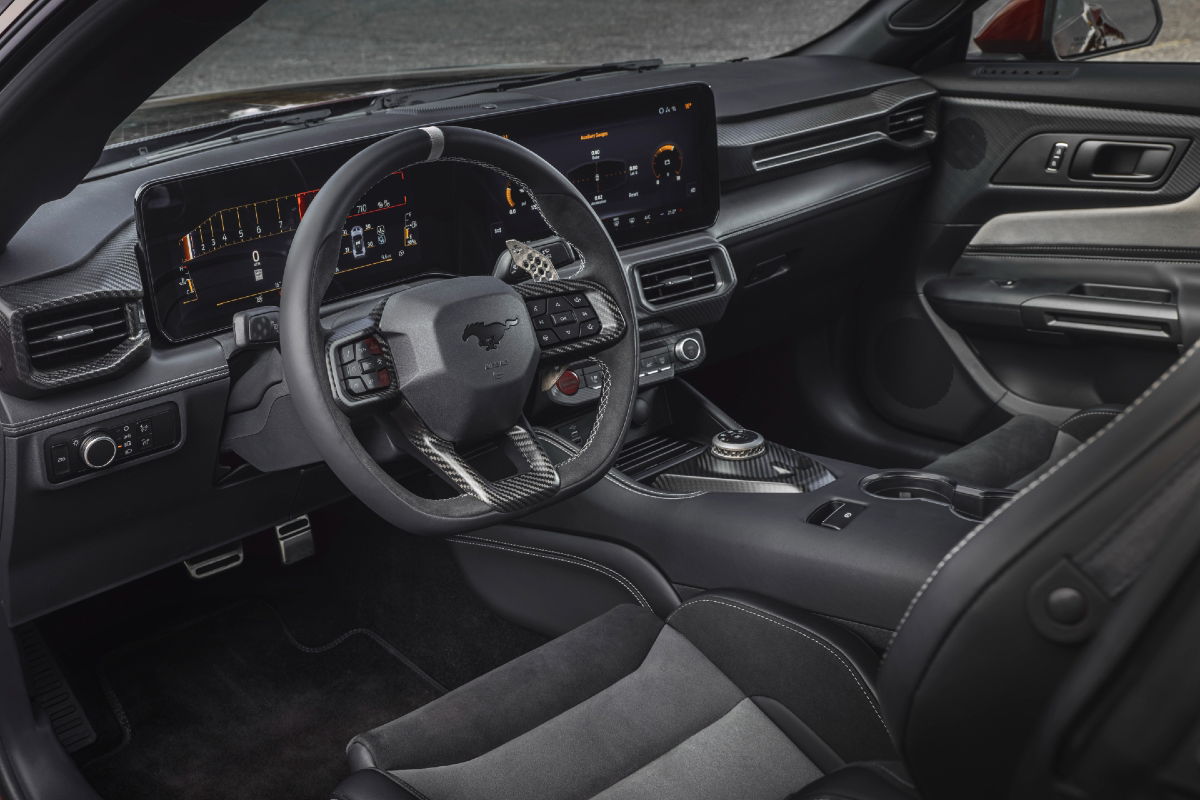
Ford did not need to make the Mustang GTD, but it wanted to.
That should tell you everything you need to know about this ultimate version of the iconic pony car.
When Ford CEO Jim Farley first hinted at the GTD at the launch of the seventh-generation Mustang in September 2022 he suggested it would be a homologation special for the new GT3 racing car that is competing at Le Mans, Daytona and around the world.
“To go to Le Mans you need a road car,” Farley said.
READ MORE: New race-inspired Ford Mustang GTD ‘supercar’ detailed
However, the real story has now emerged and the simple fact is, the Mustang Dark Horse is the homologation model for the GT3 entry, as the latest rules allow for significant technical freedoms. So the Mustang GTD is actually just the latest in a long line of so-called ‘passion projects’ for the blue oval, that also include the revived GT supercar and Bronco Desert Racer.
Speaking at the public display of the GTD at the 24 Hours of Le Mans, Ford Performance global director, Mark Rushbrook revealed that Farley gave the greenlight to the road car project after seeing the early development work on the GT3 race car.
“We don’t wanna make boring cars and to have something like this, it is a passion product,” Rushbrook explained. “You’re right, we didn’t have to do it but as soon as Jim saw the GT3 there was no hesitation. It was, ‘we need one of those for this street’. No question. It was, ‘we’ve got to do this.’”
So the Mustang Dark Horse formed the basis of the Mustang GT3, which in turn acted as inspiration for the Mustang GTD.
VIDEO: Hear the stunning Ford Mustang GTD V8 on track
Meeting with the media, including Torquecafe, at Le Mans, Bill Ford, the Executive Chairman of the company his great-grandfather founded, said these performance-led programs are a key part of the brand’s culture and will remain so into the future.
“Look, we love doing great cars, and the success of the GT, even though it was very expensive, was something that we were very proud of,” Ford said. “Whether it’s Raptors that we do, or Ranger or F-150 or Bronco, or obviously a GTD kind of thing. I mean, we wanna take everything to the apex and just do whatever is possible with that platform. GTD is an expression of that. I would say Raptors are an expression of that. And you’ll see more of that.”

As it did with both the GT supercar, Ford has worked with engineering and racing specialists, Multimatic, on the Mustang GTD. The Canadian company builds the Mustang GT3 (as well as supplying its chassis to the Porsche 963 LMDh program) and will also assemble the Mustang GTD at its facility, rather than have it built directly by Ford.
That’s due to the extensive changes the two companies have made to ensure the Mustang can compete with the likes of Porsche and Ferrari both on and off the racetrack. The Mustang GTD is powered by a 5.2-litre V8 with a newly-developed supercharger and dry-sump oil system (the first for a road-going Mustang) that reportedly makes 596kW (800hp). To get that power to the rear wheels, Ford has deployed a transaxle (similar to what’s used in the local racing Supercars) and the carbon fibre driveshaft to achieve almost ideal 50/50 weight distribution.
The next major advancement is the suspension, a bespoke adjustable system that allows the GTD to lower when it gets to the track by 40mm. The complex hydraulic system for the suspension – along with the transaxle and rear wing mounting posts – take up the space used as the boot on the standard Mustang and can literally be seen from the cabin thanks to a ‘window’ where the back seats should be.

The front suspension is a short-long arm set-up that Ford claims “provides enhanced lateral stiffness and improved kinematics especially in high-G cornering,” while the rear suspension is an integral link pushrod and rocker arm design with inboard Adaptive Spool Valve dampers and coil-over springs, developed by Multimatic.
This ultimate iteration of the pony car also comes clad in carbon fibre panels for much of the body and has active aerodynamics, magnesium wheels and carbon ceramic brakes.
To ensure that the limited amount of Mustang GTD that are built get into the hands of true enthusiasts Ford is requiring that all potential owners fill out an application form and state their credentials for owning such a car. This was the same process as the GT supercar and is designed to stop speculators from buying and flipping the limited special for a profit and instead sell them to people that will drive them.
The application process recently opened in Europe, having already begun in the USA, and would-be Australian buyers are reportedly able to apply through the European process as it won’t especially be active here.





















Discussion about this post